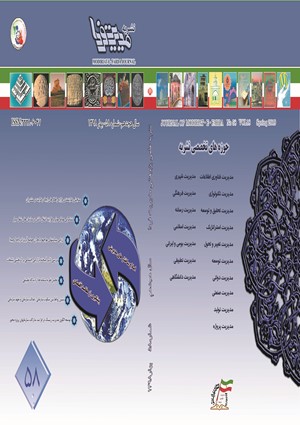An integrated model for a multi-product production-inventory-routing problem in a bi-echelon green supply chain
Subject Areas : مدیریت صنعتیAdel Aazami 1 , Ali Papi 2 , mir saman pishvaee 3
1 - University of Science and Technology
2 - University of Science and Technology
3 - Iran University of Science and Technology
Abstract :
Manufacturing company’s decisions regarding the quantity of production and inventory is a production planning and inventory control problem. Decisions about transferring products are expressed as a transportation and routing problem. Considering these three problems together results in an integrated production-inventory-routing planning (PIRP) which is one of the important supply chain problems. Companies which solve their PIRP problems better can decrease the cost of their products and gain more competitive advantage compared to other competing companies. Based on today’s strict regulations, companies must take into account environmental considerations in addition to economical ones in all their processes, from production until supply. Thus, an appropriate transportation planning can prevent the excessive increase in costs and decrease environmental pollution. Therefore, this study integrates the problem of decreasing environmental pollution with PIRP and develops a green PIRP (GPIRP) problem which efficiently considers the economic and social dimensions of production and supply. This problem is modeled in an integrated manner using the MILP approach. In order to show the applicability of the developed model and its practicability of environmental aspect, a case study is conducted on Ahvaz Sugar Refinery, Iran. Finally, some managerial insights are derived from the computational results.
[1] Dantzig GB, Ramser JH (1959) The truck dispatching problem. Manage Sci 6:80–91.
[2] Fumero F, Vercellis C (1999) Synchronized development of production, inventory, and distribution schedules. Transp Sci 33:330–340.
[3] Brown G, Keegan J, Vigus B, Wood K (2001) The Kellogg company optimizes production, inventory, and distribution. Interfaces (Providence) 31:1–15.
[4] Gupta V, Peters E, Miller T, Blyden K (2002) Implementing a distribution-network decision-support system at Pfizer/Warner-Lambert. Interfaces (Providence) 32:28–45.
[5] Sindhuchao S, Romeijn HE, Akçali E, Boondiskulchok R (2005) An Integrated Inventory-Routing System for Multi-item Joint Replenishment with Limited Vehicle Capacity. J Glob Optim 32:93–118.
[6] Lei L, Liu S, Ruszczynski A, Park S (2006) On the integrated production, inventory, and distribution routing problem. IIE Trans 38:955–970.
[7] Boudia M, Louly MAO, Prins C (2006) A memetic algorithm with population management for a production-distribution problem. IFAC Proc Vol 39:541–546.
[8] Boudia M, Louly MAO, Prins C (2007) A reactive GRASP and path relinking for a combined production–distribution problem. Comput Oper Res 34:3402–3419.
[9] Yu Y, Chen H, Chu F (2008) A new model and hybrid approach for large scale inventory routing problems. Eur J Oper Res 189:1022–1040.
[10] Bard JF, Nananukul N (2009) The integrated production–inventory–distribution–routing problem. J Sched 12:257–280.
[11] Oppen J, Løkketangen A, Desrosiers J (2010) Solving a rich vehicle routing and inventory problem using column generation. Comput Oper Res 37:1308–1317.
[12] Bard JF, Nananukul N (2010) A branch-and-price algorithm for an integrated production and inventory routing problem. Comput Oper Res 37:2202–2217.
[13] Moin NH, Salhi S, Aziz NAB (2011) An efficient hybrid genetic algorithm for the multi-product multi-period inventory routing problem. Int J Prod Econ 133:334–343.
[14] Coelho LC, Cordeau J-F, Laporte G (2012) The inventory-routing problem with transshipment. Comput Oper Res 39:2537–2548.
[15] Coelho LC, Cordeau J-F, Laporte G (2013) Thirty years of inventory routing. Transp Sci 48:1–19.
[16] Mirzapour Al-e-hashem SMJ, Rekik Y (2014) Multi-product multi-period Inventory Routing Problem with a transshipment option: A green approach. Int J Prod Econ 157:80–88.
[17] Bertazzi L, Bosco A, Laganà D (2015) Managing stochastic demand in an Inventory Routing Problem with transportation procurement. Omega 56:112–121.
[18] Adulyasak Y, Cordeau J-F, Jans R (2015) The production routing problem: A review of formulations and solution algorithms. Comput Oper Res 55:141–152.
[19] Yantong LI, Feng CHU, Zhen Y, Calvo RW (2016) A Production Inventory Routing Planning for Perishable Food with Quality Consideration. IFAC-PapersOnLine 49:407–412.
[20] Agra A, Cerveira A, Requejo C (2016) Lagrangian Relaxation Bounds for a Production-Inventory-Routing Problem. In: Pardalos PM, Conca P, Giuffrida G, Nicosia G (eds) Mach. Learn. Optim. Big Data Second Int. Work. MOD 2016, Volterra, Italy, August 26-29, 2016, Revis. Sel. Pap. Springer International Publishing, Cham, pp 236–245
[21] Hasni S, Toumi S, Jarboui B, Mjirda A (2017) GVNS based heuristic for solving the multi-product multi-vehicle inventory routing problem. Electron Notes Discret Math 58:71–78.
[22] Chitsaz M, Cordeau J-F, Jans R (2017) A Unified Decomposition Matheuristic for Assembly, Production and Inventory Routing. Cah. du GERAD
[23] Qiu Y, Qiao J, Pardalos PM (2017) A branch-and-price algorithm for production routing problems with carbon cap-and-trade. Omega 68:49–61.
[24] Desrochers M, Laporte G (1991) Improvements and extensions to the Miller-Tucker-Zemlin subtour elimination constraints. Oper Res Lett 10:27–36.


